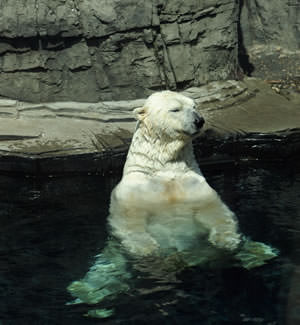Politicizing the Polar Bear
More than any other mammal (except of course Mr. Homo sapiens), Ursus maritimus, which translates as maritime bear, has been in the forefront of the news lately, the subject of television specials, lawsuits, congressional debates, and New York Times editorials. Why?
“I used to work with the dolphins at the Coney Island Aquarium,” said Celia Ackerman, “but when I got here and saw the polar bears, I was immediately converted.” Ackerman has been the bear keeper at the Central Park Zoo since about 1990, and because the only bears on exhibit are the polar bears Gus and Ida, she is, in fact, the polar bear keeper. Until recently, her charges lounged majestically in their spacious, rock-lined enclosure, which has a swimming pool with viewing windows (people looking in; bears not paying much attention to who’s looking in or tapping on the glass), but recently, the bears have become more than giant white plush toys — most visitors, of any and every age, cannot help but call the bears “cute” — they have been politicized.
I went to the zoo to photograph the bears — I needed pictures of captive polar bears for a book I’m working on — and when I got there, Ackerman had just left two “bear toys” in the bears’ enclosure, which were suitcase-size white plastic containers with fish inserted through holes at the corners. After she deposited the toys, she came up onto the viewing platform as the bears were released from their cages. Gus and Ida had no trouble figuring out how to tip the “toys” so the fish would slide out, and Ackerman said, “They’re pretty smart. Look: Gus is pounding on it with his forefeet, just like he would do on the ice if there was a seal den under him.” She laughed when I asked her what would happen if she stayed in the enclosure when the bears came out: “I don’t know, but I’m not about to find out.” Polar bears are the largest of all terrestrial carnivores — yes, taller and heavier than the largest Kodiak brown bears — with the record holder weighing in at more than a ton, and they have a reputation for ferocity that may be undeserved. I wouldn’t want to be there when the hungry bears came out to play either.
More than any other mammal (except of course Mr. Homo sapiens), Ursus maritimus, which translates as maritime bear, has been in the forefront of the news lately, the subject of television specials, lawsuits, congressional debates, and New York Times editorials. Why? Global warming is melting the Arctic ice cap, and as the ice recedes, the seals that breed on the ice are becoming scarcer. Polar bears are, unlike grizzlies and black bears, “obligate carnivores,” which means they eat meat almost exclusively, and on the Arctic ice, meat means seals. If the seals are harder to find, the bears have to wander further offshore, but melting ice means that offshore is getting further and further away.
The Arctic Ocean, which bathes the icy shores of northern Canada, Alaska, Greenland, Russia (the northern coast of Russia is the longest east-west coastline in the world) and the islands of Spitsbergen (which belongs to Norway), surrounds the geographic North Pole, which is actually underwater. (The South Pole is in the middle of the Antarctic continent and is thus on land.) When adventurers like Robert E. Peary tried to reach the North Pole, they walked or sledged across the ice that covered the Arctic Ocean, but nowadays you could reach the pole only by boat or by swimming. I went to the North Pole in 1994 on a Russian icebreaker, and when we arrived at 90 degrees north, we celebrated by going for a quick dip in a hole that the crew had chopped in the 10-foot-thick ice. By the summer of 2000, the ice over the pole was no longer in evidence, and a front-page story in The New York Times was titled “Age-Old Icecap at North Pole Is Now Liquid, Scientists Find.” This was one of the first signs that the polar bears were in trouble, although few people realized it at the time.
By now, Nanook the polar bear has become a morphologically unlikely canary in the coal mine — the worldwide symbol for global warming. In “An Inconvenient Truth” (book and movie) Al Gore chose to illustrate the retreat of the Arctic ice cap by showing that polar bears, unable to find the seals that they had hunted for millenniums, swam in search of ice that was not there, until they drowned. This may have actually happened in a couple of instances, but there probably wasn’t going to be a lemming-like mass migration of polar bears, and a few of the bears turned around and headed inland in search of food, some of them fetching up as far from their usual range as Newfoundland. Still, a decrease in Arctic ice means a decrease in seals, and a decrease in seals means that polar bears can’t get enough to eat. (Don’t even ask about moving the bears to the Antarctic so they can eat penguins.) We can’t protect the bears from global warming, but if we recognize that the bears are in trouble, we might do whatever we can think of to protect them. Some estimates suggest that the polar bear will be extinct in the wild in 2050.
The Endangered Species Act was passed specifically to protect species in trouble, so listing polar bears as endangered would afford them some protection, at least in U.S. territory. In the so-called Polar Bear Nations (the U.S., Canada, Russia, Greenland and Norway), only aboriginal peoples can legally hunt polar bears, but exceptions are made for native people to serve as guides for hunters who are not themselves Eskimos or Inuits. In fact, a considerable proportion — sometimes all — of the income for some native villages come from hunting licenses, so listing the polar bear as endangered would have a catastrophic effect on these native villages. They are therefore opposed to changing the status of Nanook, but their voices are but whimpers compared to the mighty roar of the oil companies. If the polar bear was to be listed, that might mean that the oil companies could not explore for oil in the polar bears’ habitat, and it just so happens that the Department of Minerals Management offered some prime packages of the Chukchi Sea for oil leases in February 2008. But back in December 2006, Secretary of the Interior Dirk Kempthorne announced that the U.S. Fish and Wildlife Service was proposing to list the polar bear as a “threatened” species under the Endangered Species Act and initiated a scientific review to determine the status of the species. Everyone agrees that the Arctic ice pack is shrinking, and it therefore stands to reason that the bears that rely on it should somehow be protected. In 1972, President Nixon called on Congress to pass comprehensive endangered species legislation. Congress responded by creating the Endangered Species Act (ESA), which was signed into law on Dec. 28, 1973. That same year saw the creation of the Convention on International Trade in Endangered Species of Wild Fauna and Flora (CITES), an international agreement restricting international commerce in plant and animal species believed to be actually or potentially harmed by trade. The U.S. CITES list includes all species protected by the ESA in addition to species that are vulnerable but not yet threatened or endangered. The stated purpose of the Endangered Species Act is to protect species and also “the ecosystems upon which they depend.” Listing the polar bear, with its diminishing population and its disappearing habitat, would seem to be a no-brainer, but there are some people in Alaska and elsewhere who disagree.
If the polar bear is listed as endangered, subsistence hunting and oil prospecting (not to mention oil drilling) would have an adverse effect on the bears and would be prohibited under the Marine Mammal Protection Act. “The state of Alaska,” wrote Tom Kizzia in the Anchorage Daily News (Sept. 8, 2007), “fearing consequences for subsistence hunting and oil production, has strenuously opposed a federal threatened-species listing, arguing, among other things, that bear populations have been stable and that too much uncertainty surrounds global warming trends.” But there is no uncertainty in the 2006 report by James Hansen et al., in which they stated that in the past 30 years average world surface temperatures have increased 0.2 degrees C per decade, but parts of the Arctic have experienced tenfold the average warming. The U.S. Geological Survey Reports that Secretary Kempthorne requested have now been issued, and the overall conclusion reads as follows:
“Projected changes in sea ice conditions, if realized, will result in loss of approximately two-thirds of the world’s polar bear population by the mid-21st century. Because the observed trajectory of Arctic sea ice decline appears to be underestimated by current available models, this assessment of future polar bear status may be conservative.”
It’s much worse than we thought. “Ultimately,” the report concludes, “we projected a 42% loss of optimal bear habitat during summer in the polar basin by mid century.” And no, the bears will not fare well converting to land-based hunting; they are poorly equipped for chasing reindeer or musk oxen, and besides, those herbivores do not provide the high-calorie nutrition that the bears need. Listing the polar bear as endangered will not cool the Arctic and stop the ice from melting, but encouraging sport hunting and oil drilling in the bears’ Alaska habitat will speed them along the slippery slope toward extinction.
On Jan. 2, 2008, The New York Times ran an editorial titled “Of Two Minds on Polar Bears”:
“Listing the polar bear would trigger a series of protections, including, in time, identifying habitat critical to the bears’ survival. It would also impose obligations on all federal agencies to avoid actions that could hurt the bears’ prospects. But the minerals service, where the wishes of the oil and gas industry carry great weight, has a history of doing as it pleases. Environmental groups and members of the House and Senate are thus asking Dirk Kempthorne, the interior secretary, to declare a timeout, postponing Chukchi Sea lease sales for three years pending further scientific study. … “The urgent and immediate question, though, is the future of the polar bear, which is bleak enough without further stresses. Everyone agrees that the over-whelming threat is the loss of sea ice, where the bears hunt for food and nurture their young. Yet there is also wide recognition among federal scientists, even in the minerals service, that the many activities associated with oil drilling — the seismic tests, the vast increase in ship traffic, the noise, the potential spills — can only weaken the bear’s resilience.”
The U.S. government is not likely to heed such editorials, and two days after publication of the New York Times opinion the Minerals and Management Service announced that it would seek bids for petroleum licenses in the Chukchi Sea on Feb. 6. Under consideration is a 46,000-square-mile area between Alaska and the coast of the Russian Far East, which is said to hold 15 billion gallons of recoverable oil and a huge volume of natural gas. It is also the home of one of the main populations of polar bears in U.S. and Russian territory, as well as large walrus herds. In response to the announcement, Margaret Williams of the WWF (formerly the World Wildlife Fund) said, “The chances for survival of this icon of the Arctic will be greatly diminished if its last remaining critical habitat is turned into a vast oil and gas field.” Brendan Cummings of the Center for Biological Diversity in San Francisco responded to the announcement even more dramatically, saying, “The polar bear is in need of intensive care, but with this lease sale the Bush administration is threatening to burn down the hospital.” Alaska Gov. Sarah Palin responded by submitting an Op-Ed piece to The New York Times (published last Jan. 5), in which she argued against listing the polar bear, saying that “polar bears are more numerous than they were 40 years ago” and they don’t need government protection. She suggests that “climate change” is the only threat to the bears, never mentioning the real reason that environmental groups are in favor of the listing: that oil and gas drilling would wreak havoc with the bears’ Alaskan habitat. Writing in The San Francisco Chronicle, Jane Kay said, “Environmental groups fear that political meddling and a rush to sell oil leases in Arctic waters are behind the Bush administration’s announcement that it will miss a legal deadline to determine whether to list the polar bear under the Endangered Species Act. … Major environmental groups, including the Sierra Club, National Resources Defense Council, and Greenpeace, as well as some congressional leaders … fear that the polar bear decision has been purposefully delayed to allow a first-time oil lease sale to go forward Feb. 6 in Alaska’s pristine Chukchi Sea, which provides one-tenth of the habitat for the world’s polar bears.”
The oil and gas industry has contributed millions of dollars to Alaskans; the polar bear hasn’t contributed much except a few pretty pictures and an uncomfortable controversy about endangered species. One of the Alaskans who has benefited from the Alaska pipeline is Ted Stevens, the longest-serving senator in the history of the Republican Party. In the Fairbanks Daily News-Miner (Jan. 10, 2008) Stevens said that listing the polar bear under the Endangered Species Act would impact oil and gas leasing on Alaska’s North Slope and possibly offshore and could even block the development of a natural gas pipeline. “If the polar bear is listed,” he said, “its habitat will be subject to new criteria as far as any development, and the major development being considered today in the polar bear habitat is the natural gas pipeline.” The listing is unnecessary, he continued, “and backed largely by environmentalists bent on blocking development projects.” Those darned environmentalists! Worried about a few bears when there’s millions to be made from another pipeline!
Most Alaskans — and almost all Alaskan politicians — are in favor of the oil leases, and opposed to the listing of the polar bear. If the Chukchi Sea wells come in, it would probably mean another pipeline and another bonanza for Alaskans. Don Young, the sole U.S. House member from Alaska since 1973, said in an Associated Press interview, “This is yet another example of how a law with the best of intentions has been subverted by the lawyers for the extreme environmental organizations and the liberal Democratic leadership.” (Young, a Republican, is under federal investigation for possibly taking bribes, illegal gratuities or unreported gifts.) The same politicians are ardently sup-porting the opening of oil drilling in the Arctic National Wildlife Refuge, despite opposition from environmentalists and politicians in the Lower 48.
Canadian Inuit leaders criticized environmentalists for pushing Washington to declare the polar bear a threatened species, saying the move was unnecessary and would hurt the local economy by deterring American hunters who spend millions of dollars a year to shoot the animals in northern Canada. Mary Simon, president of the Inuit Council (Tapiriit) of Canada, said, “The polar bear is a very important subsistence, economic, cultural, conservation, management, and rights concern for Inuit in Canada. It’s a complex and multilevel concern. But it seems the media, environmental groups, and the public are looking at this in overly simplistic black-and-white terms as the demise of the polar bear from climate change and sports hunting.”
Fearful that politics would take precedence over conservation and that Lease Sale 193 would occur before the polar bear could be listed under the Endangered Species Act, Chairman Edward J. Markey (D-Mass.) of the House Select Committee on Energy Independence and Global Warming introduced legislation on Jan. 17, 2008, that would compel the Bush administration to protect the polar bear before it allows widespread oil drilling in Alaska. On the day of the hearings, the committee published Markey’s remarks: “Robert Frost wrote about two roads diverging in the wood, and here we have the Bush administration looking down two roads with regard to the polar bear. Down one road lies the survival of the polar bear and the orderly consideration of oil drilling and global warming and common sense. Down the other road, too often traveled by this administration, lies regulatory lunacy and a blatant disregard for moral responsibility. I urge Secretary Kempthorne and his agency to choose the Bush administration’s road less traveled and protect the polar bear, and the rest of us, from global warming.”
In early January, the Fish and Wildlife Service announced it would miss the statutory deadline to reach a decision on listing the polar bear as threatened under ESA as a result of global warming, saying it would take up to a month more to reach the decision. That could put the listing decision after the sale of oil drilling rights in Alaska’s Chukchi Sea. The Chukchi Sea is a sensitive polar bear habitat, and the oil drilling area up for sale overlaps major parts of the polar bears’ essential habitat. The legislation proposed by Markey would require that the Interior Department delay the oil drilling rights sale in the Chukchi Sea until it had made a decision on the polar bear, and had performed its responsibility of establishing a “critical habitat” for the polar bear.
Jan. 15, 2008: In another New York Times editorial (“Regulatory Games and the Polar Bear”) we read:
“Although Congress and the courts have largely frustrated the Bush administration’s efforts to open up Alaska to oil and gas drilling, Vice President Dick Cheney and his industry friends remain determined to lock up as many oil and gas leases as they can before the door hits them on the way out. They are certainly not going to let the struggling polar bear stand in their way. “The Interior Department’s Minerals Management Service has announced that early next month it will sell oil and gas leases on nearly 30 million acres of prime polar bear habitat in the Chukchi Sea. Meanwhile, the department’s Fish and Wildlife Service has postponed a long-awaited decision on whether to place this iconic and troubled animal on the list of threatened species. … “That would give [department] scientists more time to assess the threats to the bear and other fragile wildlife. The department could also use the time to figure out how and where drilling may safely proceed, if at all. There is no urgency to lease Alaskan waters. President Bush’s suggestion that new oil production will bring short-term relief at the pump is nonsense, since oil fields take years to develop. It is urgent to help the bears.”
Two weeks later, as if in response to this impassioned editorial, The Wall Street Journal published an editorial of its own, “The Polar Bear Express,” in which it took exactly the opposite position from everyone who believed that the bears were threatened and would be even more so if drilling was allowed in their habitat. For example, the editorial states, “The problem is that polar bear populations have been rising over the past four decades and may be at an historic high.” But polar bear populations throughout the Arctic have fallen precipitously over the past four decades, and some are at 60 percent of what they were in 1960. Naturally, the head-in-the-sand editorialists at the Journal were prepared to argue that global warming isn’t really a problem at all, writing, “These projections are speculative, however, and tend to underestimate the dynamism of the environment. Animals adapt to changing conditions, which might mean a shift in population patterns to areas where pack ice is more robust year-round.”
But every climatologist knows that there has been a drastic loss of the Arctic sea ice, and that this loss will only increase. To suggest that it is up to the bears to “adapt to changing conditions” flies smack in the face of evolutionary history: Failure to adapt to changing conditions is one of the primary causes of extinction. Said the Journal: “The logical — and dangerous — leap here is that the greens are attempting to re-write the Endangered Species Act without actual legislation. If the ‘iconic’ polar bear is classified as threatened, and the harm is formally attributed to warming caused by humans, then their gambit would lead to all sorts of regulatory mischief.” But as written, and without any modification, the Endangered Species Act protects the habitat of a species classified as threatened (not to mention endangered), and the very act of drilling in the Chukchi Sea is hazardous to the bears — think of oil spills, which are part of the process — and nobody, except perhaps the editorial writers at the Journal, denies that global warming is caused by humans. What the Journal calls “a modest sale of oil and gas leases” is actually an auction of leases in nearly 46,000 square miles — an area the size of Pennsylvania — of prime polar bear habitat in the Chukchi Sea.
In opposition to the listing of the bear as an endangered species, people like Gov. Palin of Alaska have pointed out that polar bear populations have risen in the last several decades. In many cases they have, but that may have to do with the reduction in sport hunting, and anyway, an increase in the populations is not a justification for leaving them unprotected. The threat to the bears lies in the realization that the disappearing ice cap will endanger their habitat and their lives, and an increased population only means that more bears will have less food.
After weeks of anxious waiting on the part of environmentalists, the decision was made last Feb. 6 to allow the Department of the Interior to move ahead with the auction of oil leases in the Chukchi Sea. Immediately, Royal Dutch Shell bid $105 million for a single exploration block, and $2.1 billion for 275 tracts. The last lease sale in the Chukchi, held in 1991, brought in a total of only $7.4 million. About 25 years ago, Shell had explored some of the same regions it leased in 2008 but had relinquished the leases as uneconomic. Now, high oil prices have transformed previously undesirable high-cost regions into exploration hot spots for oil companies — and extinction hot spots for polar bears.
On March 11 a coalition of environmental groups sued the Bush administration for delaying a decision to protect the polar bears. The Center for Biological Diversity, Greenpeace and the Natural Resources Defense Council filed the suit over the government’s missing the legal deadline for issuing a final decision on whether to list the polar bear under the Endangered Species Act. Had the Fish and Wildlife Service listed polar bears as threatened on Jan. 9, the Chukchi Sea lease sale could not have gone ahead without critical studies to assess the potential impacts on polar bears. Should the polar bears be listed as threatened in the near future, the U.S. government would have an obligation to protect their habitat, and that might mean having to buy back the Chukchi leases from the energy companies, at a premium price. As this seems more than a little unlikely, the bears might have to figure out how to protect themselves. And on April 17, having missed its deadline by more than three months, the Interior Department announced that it needed an additional 10 weeks because of “the complexity of the legal and scientific issues.” Kassie Siegel, spokesperson for the Center for Biological Diversity, said “these are not questions for attorneys, they’re questions for scientists.” She also said that the request for more time was probably a tactic by political appointees to delay a decision until the Mineral Management Service could finish issuing Chukchi leases to further protect the leases from legal challenges. On April 29 U.S. District Judge Claudia Wilkin ruled that the Bush administration had two weeks to decide whether polar bears deserve protection under the Endangered Species Act because of impacts from the warming climate. “Today’s decision is a huge victory for the polar bear; by May 15th the polar bear should receive the protection it deserves,” said Siegel. The court rejected a request by the Interior Department for more time, saying, “Defendants offer no specific facts that would justify the existing delay, much less further delay. To allow defendants more time would violate the mandated listing deadlines under the ESA and congressional intent that time is of the essence in listing threatened species.” The Bush administration has argued in various courts, including the U.S. Supreme Court, that such efforts will fail because, among other things, the “remedy” for limiting global warming must be applied globally, not just in the United States.
One day before the Interior Department was to appear in court to respond to the environmentalists’ lawsuit, Dirk Kempthorne declared the polar bear “threatened” under the Endangered Species Act. Even though it took pressure from environmental groups to force the release of the report, Interior had known for a long time that the bears were in trouble. At 368 pages, “Determination of Threatened Status for the Polar Bear Throughout Its Range” could not have been assembled overnight. It incorporates a complete natural history of the polar bear; a detailed discussion of the condition of polar bear populations around the world; a comprehensive analysis of the decline of the Arctic sea ice; inclusion of the relevant statutes and acts; and specific recommendations under the law.
At the May 14 press conference at which he announced the decision, Kempthorne said:
“Today I am listing the polar bear as a threatened species under the Endangered Species Act. I believe this decision is most consistent with the record and legal standards of the Endangered Species Act — perhaps the least flexible law Congress has ever enacted. I am also announcing that this listing decision will be accompanied by administrative guidance and a rule that defines the scope of impact that my decision will have, in order to protect the polar bear while preventing unintended harm to the society and economy of the United States. … This has been a difficult decision. But in the light of the scientific record and the restraints of the inflexible law that guides me, I believe it was the only decision I could make.”
On its face, this seemed like a victory for the environmentalists and the bears — in The Wall Street Journal, Ian Talley wrote “The Bush Administration handed environmentalists a major victory” — but it was actually a ruling that provided almost no protection for the bears, while the government announced that it would not stand in the way of oil prospecting in the bears’ habitat. Listing the polar bear as “threatened” under the ESA meant that bears shot in Canada (whole or in parts) could not be brought into the United States, so in that reading, a few bears were protected, but otherwise bears at risk because the sea ice was melting were no better off than they were before Kempthorne’s announcement. Acknowledging that global warming has caused the retreat of Arctic ice, and that human activities had “some impact” on climate change, he said that no link could be made between any individual power plant or effort to drill for gas or oil, and the fate of the bear. “The loss of sea ice, and not oil and gas exploration or subsistence activity, is the primary threat to the bear,” he said. Via Kempthorne, the administration is invoking a loophole called the 4(d) rule that limits protection for the ice bears and their shrinking sea-ice habitat in areas where oil and gas development is planned or proceeding. Essentially the administration has signaled that it will extend the bears no greater protection from oil and gas development than they previously had under the Marine Mammal Protection Act.
Avoiding the obvious connections between greenhouse gases, global warming and the loss of the bears’ hunting grounds, Kempthorne said that his ruling “should not open the door to use the ESA to regulate greenhouse gases from automobiles, power plants and other sources. That would be a wholly inappropriate use of the Endangered Species Act. ESA is not the right tool to regulate global climate change.” Kempthorne was parroting the words of George W. Bush, who announced in April that “the Clean Air Act, the Endangered Species Act, and the National Environmental Policy Act were never meant to regulate global climate change.” Such a position is logically and ethically indefensible. For the administration to determine that the polar bear is threatened, it had to conclude that global warming will melt the ice that polar bears need to survive. Having reached that conclusion, the administration is required by the Endangered Species Act to take action to slow global warming. The Bush administration cannot decide not to do its job and enforce the law at the same time.
The fate of the polar bears is still undecided. Oil leases have been issued, and Interior has just ruled that, despite their listing of the polar bear as “endangered,” it would be OK if some of the bears were harmed (for which read: shot) by oil drillers in pursuit of their valuable product — which is certainly more valuable than any old bears. Gov. Palin of Alaska is suing the federal government, holding that protecting the polar bear interferes with Alaska’s economic development, and Safari Club International, a Dallas-based organization dedicated to “protecting the freedom to hunt,” is suing the U.S. government too, requesting that the polar bear be removed from the endangered species list so that its members would not be deprived of the opportunity to shoot a polar bear in Canada and bring home the trophy head or hide.
Mindless of the controversies surrounding them, Arctic polar bears roam what’s left of the Arctic ice, looking for seals to eat or a snowbank in which to dig a den. Maybe the bears in the Central Park Zoo are the lucky ones: Even though they’re stuck in a poor approximation of their vast, icy habitat, at least nobody’s going to drill for oil in their enclosure, and nobody’s going to shoot at them. They will be able to live out their lives unthreatened, unlisted and unconcerned about where their next meal is coming from. The way things are going now, polar bears like Gus and Ida may be the only ones our grandchildren will ever see.
Richard Ellis is the author of numerous works on maritime life, including “Tuna: A Love Story,” to be published next month by Alfred A. Knopf. He is also at work on a definitive history of the polar bear and the continuing threat to its survival posed by global warming.
Your support matters…Independent journalism is under threat and overshadowed by heavily funded mainstream media.
You can help level the playing field. Become a member.
Your tax-deductible contribution keeps us digging beneath the headlines to give you thought-provoking, investigative reporting and analysis that unearths what's really happening- without compromise.
Give today to support our courageous, independent journalists.






You need to be a supporter to comment.
There are currently no responses to this article.
Be the first to respond.